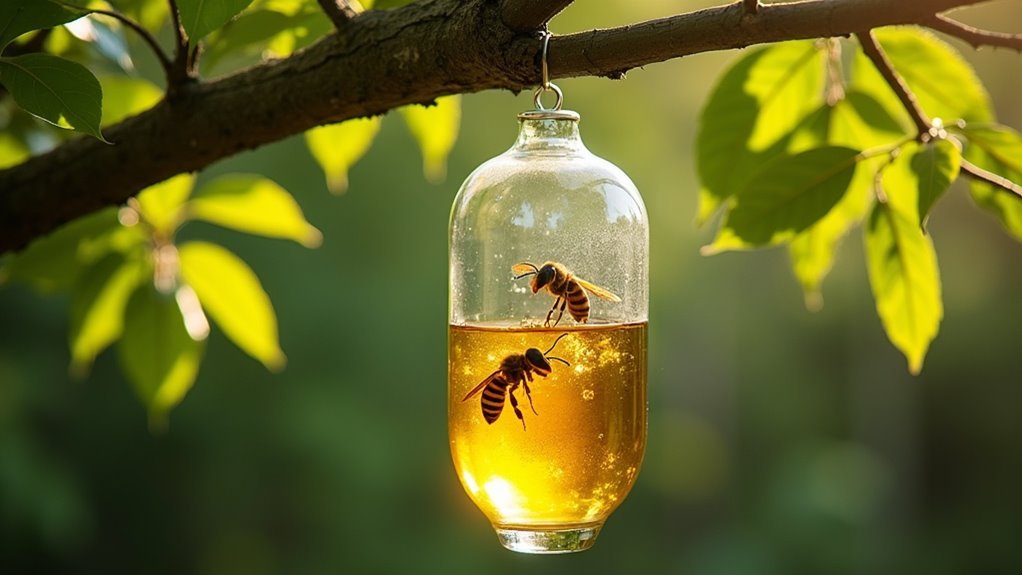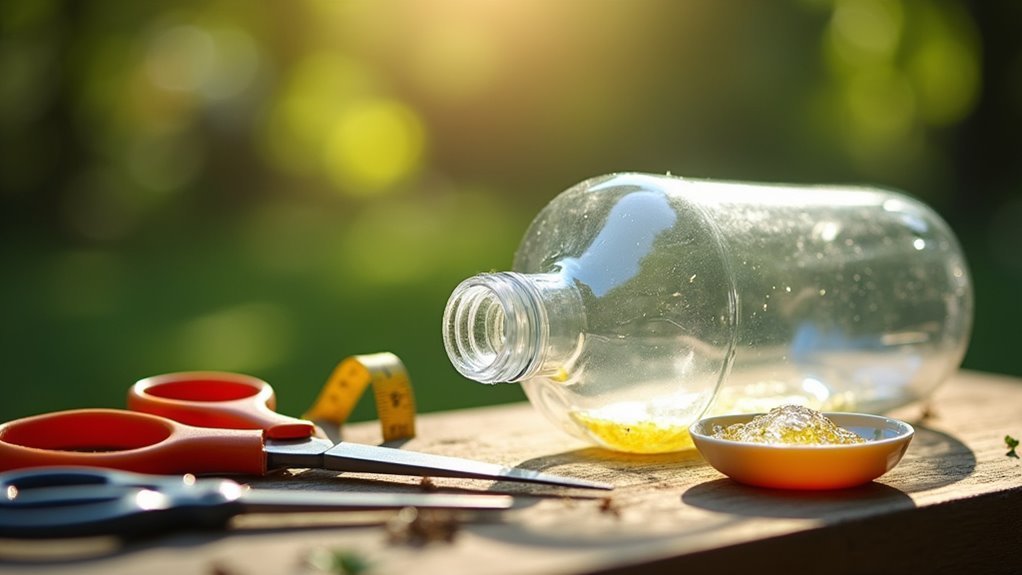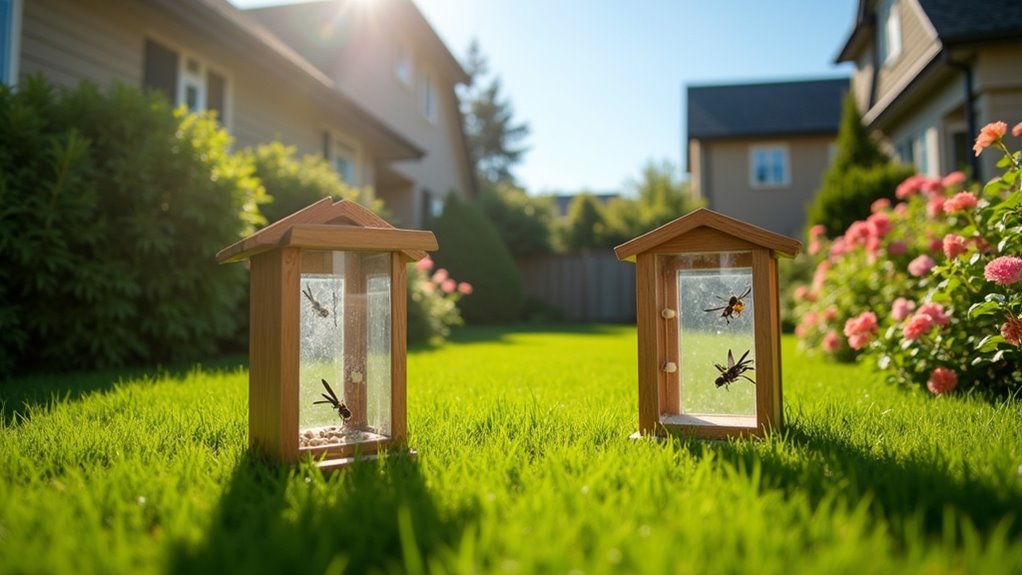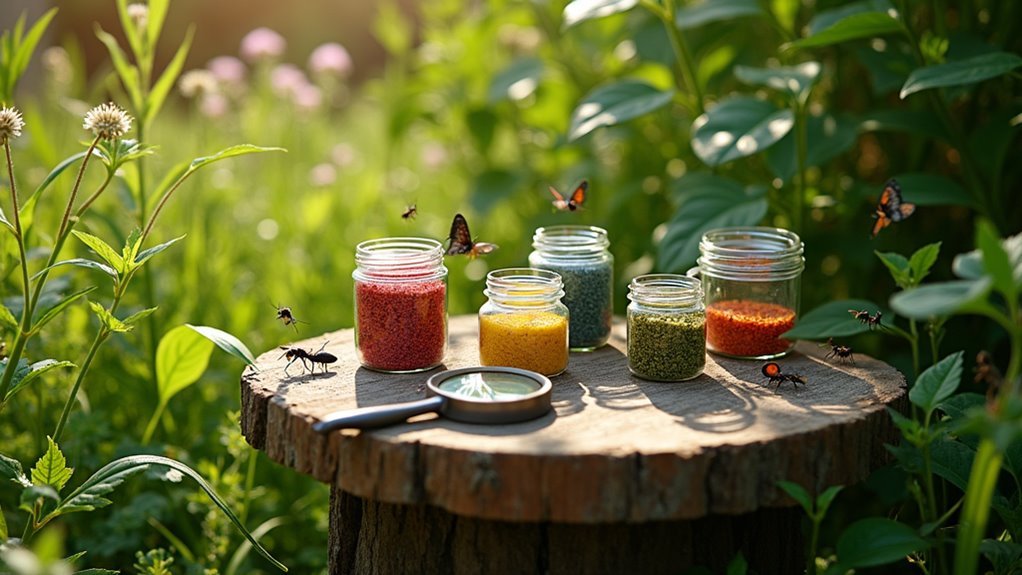You can build an effective hornet trap using a plastic soda bottle, sharp knife, and simple bait mixture of white vinegar, sugar, and salt. Cut the bottle below its taper, invert the top section into the bottom to create a funnel entrance, and secure with tape. Place your trap 20-30 feet from dining areas and 5-10 feet off the ground in shaded locations. Switch between protein-rich baits in spring and sugary options in fall for ideal results throughout the season.
Understanding Hornet Behavior and Identification

Hornets present a unique challenge for homeowners due to their size, aggression, and social nature. You’ll need to distinguish hornets from other insects before setting effective traps.
These wasps and hornets differ greatly – hornets are noticeably larger, sometimes reaching 2 inches in length, while displaying distinctive black and white markings if they’re bald-faced hornets, North America’s most common species.
You’ll find hornets building paper-like nests in trees, shrubs, or elevated structures around your property. Their smooth stingers allow multiple stings, making them particularly dangerous when threatened.
Unlike bees, hornets can sting repeatedly without dying. They’re attracted to sugary substances and hunt other insects for protein.
Understanding that hornets become most aggressive when defending their nests helps you position traps strategically while maintaining safe distances from their colonies.
Essential Materials for DIY Hornet Traps
Creating an effective DIY hornet trap requires just a few common household items and the right bait mixture.
A simple homemade hornet trap uses everyday materials and proper bait to effectively remove unwanted pests from your property.
You’ll need a plastic soda bottle, permanent marker, and sharp knife or scissors for cutting. These materials form the foundation of your DIY wasp trap.
Cut around the bottle’s neck after marking a line, then invert the top section into the bottom to create a funnel entrance.
For bait that’ll attract wasps and hornets, mix 3/4 cup white vinegar, 2 tablespoons sugar, and 1 teaspoon salt.
Avoid using honey since it attracts beneficial bees instead of targeting hornets.
This simple combination of materials creates an efficient trap that draws hornets away from your outdoor spaces while protecting pollinators.
Step-by-Step Bottle Trap Construction

Once you’ve gathered your materials, begin by thoroughly cleaning your plastic bottle and removing all labels to guarantee proper adhesion for marking.
Mark a line just below where the bottle begins to taper, then carefully cut along this line to separate the top portion from the bottom half.
Next, invert the top section and insert it into the bottom half, creating a funnel entrance. This design allows hornets to easily enter but makes escape nearly impossible.
Secure the inverted top with tape or staples to make sure it stays firmly in place.
Your homemade wasp traps are now structurally complete. The key steps include:
- Cutting at the proper taper point for ideal funnel shape
- Inverting the top to create the entry mechanism
- Securing all connections to prevent gaps
Choosing the Right Bait for Maximum Effectiveness
What determines whether your trap becomes a hornet magnet or an expensive decoration? The bait you choose makes all the difference.
During early spring through early summer, use protein-rich options like lunch meat or hamburger since wasps are actively hunting for protein sources. As late summer and fall approach, switch to sugary baits such as sugar water, fruit juice, or soda when their dietary preferences shift toward sweets.
Avoid honey entirely—it’ll attract bees instead of your target wasps. Add vinegar to your bait mixture to further deter bees while drawing hornets.
Mix in a few drops of Dawn dish soap to prevent escapees once they’re trapped. Remember to refresh your bait weekly to maintain maximum effectiveness throughout the season.
Strategic Trap Placement Around Your Property

You’ll need to carefully consider where you position your hornet traps to maximize their effectiveness while keeping them away from areas where you spend time.
The distance from your dining and entertainment spaces, along with the trap’s height and how easily you can access it for maintenance, will determine your success rate.
Your strategic placement decisions can make the difference between capturing hornets before they become a nuisance and simply wasting bait in poorly positioned traps.
Optimal Location Selection
While placing hornet traps might seem straightforward, strategic positioning makes the difference between catching a few stragglers and effectively protecting your entire property.
Ideal location selection requires understanding hornet behavior and your yard’s layout. You’ll want to place each trap near areas where hornets naturally congregate while keeping them away from human activity zones.
Consider these key placement strategies:
- Distance and elevation: Position traps 20-30 feet from patios and dining areas, elevated 5-10 feet off the ground.
- Environmental preferences: Choose shaded locations where hornets stay more active and comfortable.
- Activity-based positioning: Monitor hornet movement patterns and relocate traps closer to high-traffic areas.
Remember to trap near trees, shrubs, or suspected nesting sites for maximum effectiveness while maintaining safe distances from your family’s outdoor spaces.
Distance From Activity Areas
Proper distance from high-activity areas forms the foundation of effective hornet trap placement throughout your property.
You’ll want to position each trap at least 20 to 30 feet away from patios, picnic tables, and other gathering spots where people eat and socialize. This strategic spacing diverts hornets away from your family while still capturing these aggressive insects effectively.
Think of your trap as a wasp repellent buffer zone that protects your outdoor living spaces.
By maintaining this critical distance, you’re creating a defensive perimeter that intercepts foraging scouts before they discover your barbecue or outdoor dining area.
Don’t place traps too close to high-traffic zones, as this can actually draw hornets toward the areas you’re trying to protect.
Height and Accessibility Considerations
Although ground-level placement might seem convenient, mounting your hornet traps 5 to 10 feet off the ground dramatically increases their effectiveness since hornets naturally forage and nest at elevated heights.
This strategic height positioning mimics their preferred habitat in trees and building structures.
When selecting trap locations, balance effectiveness with practical accessibility considerations:
- Use sturdy mounting systems like tree branches, fence posts, or shepherd’s hooks that can support the trap’s weight safely
- Position traps within reach of a ladder to enable regular maintenance without requiring specialized equipment
- Choose shaded locations where hornets remain active during hot afternoon hours
Remember that you’ll need to check and rebait these traps regularly, so don’t sacrifice accessibility for height.
Plan your placement to guarantee safe, convenient access while maintaining the elevated positioning that makes your traps most effective.
Seasonal Timing for Optimal Hornet Control
You’ll achieve maximum hornet control by timing your trap deployment to match their seasonal behavior patterns.
Spring offers your best opportunity to intercept scout hornets before they establish colonies, while summer requires intensive management during peak foraging activity.
Fall presents unique challenges as hornets become increasingly aggressive, but it’s also when protein-seeking workers are most vulnerable to trapping.
Early Spring Scout Prevention
When hornets emerge from hibernation in early spring, you have a narrow window to prevent major infestations before they establish colonies in your yard.
Trapping wasps during this critical scouting phase requires strategic timing and placement. Setting traps as early as March targets scout hornets searching for nesting sites, greatly reducing your chances of dealing with full colonies later.
For successful early spring scout prevention, focus on these key strategies:
- Use protein and sugar combination baits to attract hungry hornets emerging from winter dormancy
- Place traps near flowering plants and fruit trees where scouts typically forage for food sources
- Check and rebait traps weekly to maintain effectiveness throughout the scouting season
This proactive approach eliminates potential colony founders before they can establish threatening populations.
Summer Peak Activity Management
As summer arrives and hornet colonies reach their peak activity levels, you’ll face the season’s most challenging period for yard protection.
During these critical months, you must intensify your trapping strategy by positioning multiple homemade wasp traps throughout your property. Place traps in shaded locations near gardens, patios, and other food sources where wasp activity concentrates.
Switch your bait strategy as the season progresses—use protein-based attractants in early summer, then shift to sugary baits as hornets’ dietary preferences change.
Check and rebait your traps weekly to maintain effectiveness. Monitor activity patterns carefully to identify when you should add more traps or relocate existing ones.
This proactive approach guarantees your homemade wasp trap system adapts to peak summer conditions.
Fall Behavior Pattern Changes
Fall brings dramatic shifts in hornet behavior that’ll transform your trapping strategy completely. As temperatures drop, hornets abandon their protein-heavy summer diets and desperately seek sugary substances to fuel their colonies before winter arrives.
Understanding these behavioral changes helps you deploy the best bait options at precisely the right moment:
- Switch to sweet baits – Replace meat-based lures with fruit juice, soda, or sugar water as hornets crave carbohydrates.
- Target peak activity periods – Colonies reach maximum population in late summer, making early fall your most critical trapping window.
- Increase trap density – Both hornets and yellow jacket species forage more aggressively across wider territories, requiring strategic placement in high-traffic zones.
Deploy traps immediately when fall begins – capturing workers now prevents next spring’s population explosion.
Maintenance and Safety Protocols
While hornet traps can effectively reduce pest populations in your yard, they require consistent upkeep to function properly and safely. Proper maintenance involves checking traps weekly to monitor captured insects and guarantee continued effectiveness.
Regular weekly inspections and consistent maintenance are essential for hornet traps to remain effective and safe throughout the season.
Remove dead hornets promptly to prevent attracting additional pests and maintain peak trap performance.
Safety protocols are essential when handling these devices. Always wear gloves, especially if you’re allergic to wasp or hornet stings.
Replace bait weekly to keep traps appealing and maximize capture rates. Strategic positioning is vital—place traps away from outdoor dining areas to draw hornets away from people and food sources.
This approach protects your family while maintaining trap efficiency throughout the season.
Alternative Trap Designs and Methods
Beyond commercial options, you’ll find numerous DIY trap designs that prove equally effective at controlling hornet populations.
These alternative trap designs offer cost-effective solutions using common household items. You can create effective homemade traps with minimal effort and expense.
Popular DIY options include:
- Glass jar trap – Mix old jam with hot water, cover with foil, and poke a small entry hole.
- Milk jug trap – Cut off the top, invert it, and fill with sugar water or meat scraps as bait.
- Bucket trap – Fill with water, vinegar, and sugar mixture where hornets drown after being lured in.
Enhance your homemade traps by adding dish soap to break surface tension, preventing escape.
Incorporate bright colors and patterns to mimic natural food sources and increase visual appeal.
When Professional Intervention Becomes Necessary
Although DIY traps work well for small-scale hornet problems, certain situations demand professional expertise to guarantee your safety and achieve complete nest elimination.
You’ll need professional intervention when nests are located in high-traffic areas where disturbance can trigger aggressive behavior and multiple stings. If you’re dealing with nests larger than a baseball or positioned in hard-to-reach places, don’t attempt removal yourself.
Experts can accurately identify hornet species, which is essential for applying effective removal techniques and preventing future infestations. Their targeted treatments surpass DIY methods in effectiveness while reducing injury risks.
If you experience severe allergic reactions to stings, seek immediate professional help for safety and proper medical assistance.
Frequently Asked Questions
What Is the Best Bait for Hornet Traps?
You’ll want protein-rich baits like lunch meat during spring, then switch to sugary substances like fruit juice for late summer. Add vinegar to deter bees while attracting hornets effectively.
What Is the Best Thing to Keep Hornets Away?
You’ll keep hornets away by maintaining a clean yard, removing food sources, planting mint or eucalyptus, hanging fake nests, spraying diluted essential oils, and setting early spring traps.
What Is the Best Formula for Wasp Traps?
You’ll want to mix 3/4 cup white vinegar, 2 tablespoons sugar, and 1 teaspoon salt. Add a few drops of Dawn dish soap to prevent wasps from escaping once trapped.
What Attracts Hornets to a Trap?
You’ll attract hornets using sweet baits like fruit juice or sugar water, decaying protein such as meat, vinegar-sugar mixtures, bright-colored traps, and pheromones from previously captured hornets.
In Summary
You’ve now got the knowledge to tackle your hornet problem effectively. Remember that timing is essential—set your traps early in spring for best results. Don’t forget to check and maintain them regularly while prioritizing your safety. If you’re dealing with large nests or aggressive swarms, don’t hesitate to call professionals. With patience and the right approach, you’ll reclaim your outdoor space from these unwanted visitors.





Leave a Reply